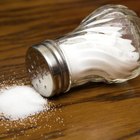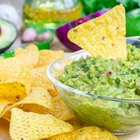
A handful of crispy and salty potato or tortilla chips is a common accompaniment to sandwiches or grilled burgers. Processed and prepared foods, such as chips, are the main source of salt in the average diet. If you are trying to limit how much sodium you consume each day, learning more about the salt content of chips may help you make healthier and lower sodium choices.
Sodium
The average person consumes 3,400 mg of sodium per day, which can have negative health ramifications. If you take in more sodium than your kidneys are able to eliminate, it begins to accumulate in your blood. When you have more sodium in your body than you need, you may begin to retain water and become bloated. If you consume too much salt for longer periods of time, you may be putting yourself at an increased risk of heart disease, heart failure, stroke and kidney disease.
Recommendations
The average diet would benefit from a reduction in sodium intake. MayoClinic.com notes that the upper limit for sodium intake should be 2,300 mg in most instances. If you are African-American, over the age of 51 or have high blood pressure, kidney problems or diabetes, you should limit your daily intake to 1,500 mg or less. These are the upper limits, and you may be able to improve your health even more by consuming less than these amounts.
Chips
While some potato and tortilla chip brands come in low-sodium varieties, the majority of your chip options contain a large amount of sodium per 1-oz. serving. A serving of regular potato chips contains 149 mg, and a serving of sour cream and onion flavored potato chips has 177 mg of sodium. The same amount of barbecue flavored potato chips contain 213 mg of sodium. A 1-oz. serving of plain tortilla chips contains about 170 mg of sodium, and nacho cheese flavored tortilla chips have 174 mg. The same size serving of ranch flavored tortilla chips contains 147 mg of sodium, and taco flavored tortilla chips have 223 mg.
Tips
If you must have chips, stick to a 1-oz. serving. It is easy to consume much more than that, which will increase the sodium content of your snack or side dish. If you eat chips on a regular basis, look for low-sodium or salt-free options. Opt for healthier snacks that are low in sodium most of the time to help keep your salt intake at a healthy level. Fresh fruits and vegetables are low in sodium and also supply many of the nutrients you need on a daily basis.
Related Articles

Are Green Bean Chips Healthy?

How to Find a Salt Substitute Without ...

Nutritional Value of Tortilla Chips vs. ...

The Nutritional Value of Tostitos White ...

How to Prepare Toothpaste From Baking ...

Calories in a Pint of Egg Drop Soup

Which Is Healthier, Lima Beans or ...

Can I Eat Sushi Twice a Week?
Snacks Compatible With a Diet for Gout

Salt-Free Diet Menus

Chili Sauce Substitutes

Is Fat-Free Sour Cream Healthy?

Vegetables That Contain Salt

Foods to Avoid to Prevent Gout
Calories in a Cucumber and Avocado Roll

Foods High in Fiber & Calcium

Benefits of Sea Salt Glow Body Treatment

How Many Calories in a Taco Bell Bean ...

Swiss vs. Cheddar Cheese Nutrition ...

Nutrition Information on Blueberries
References
Writer Bio
Sara Ipatenco has taught writing, health and nutrition. She started writing in 2007 and has been published in Teaching Tolerance magazine. Ipatenco holds a bachelor's degree and a master's degree in education, both from the University of Denver.
Photo Credits
Pixland/Pixland/Getty Images